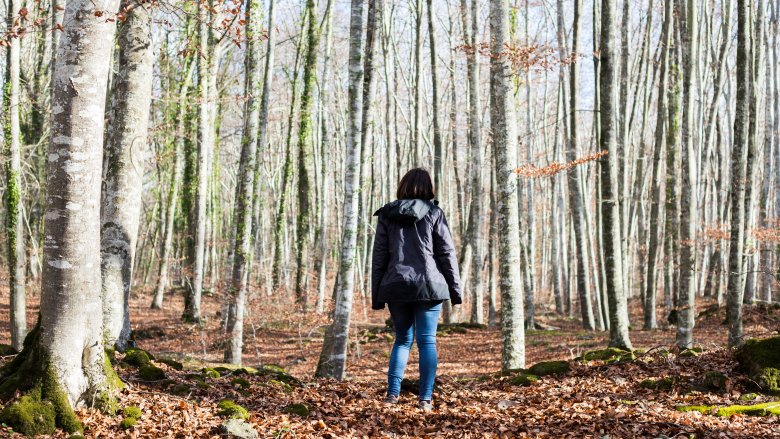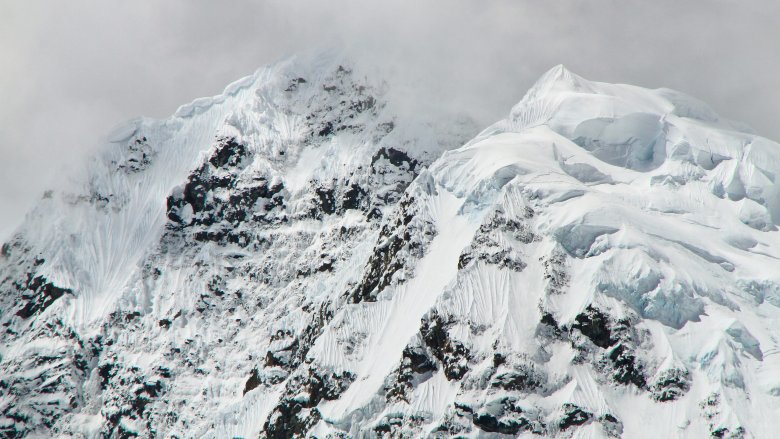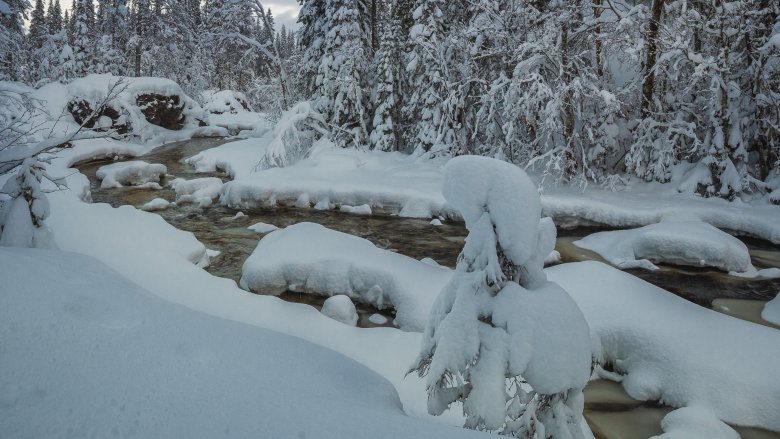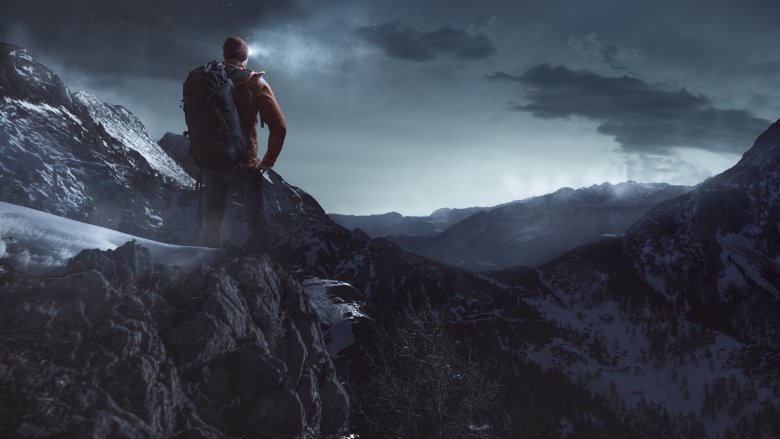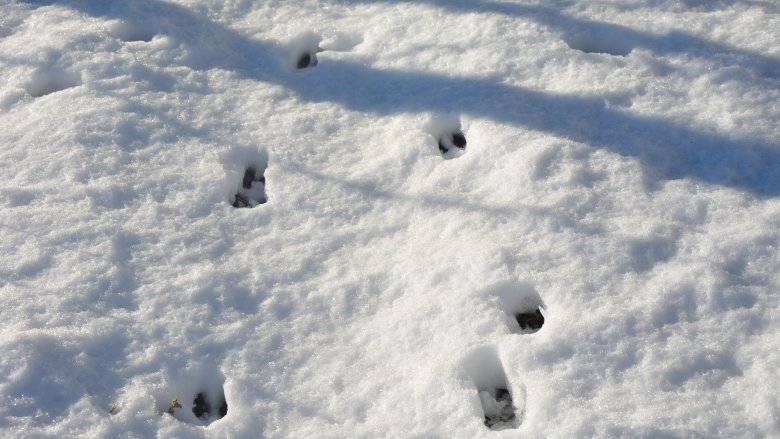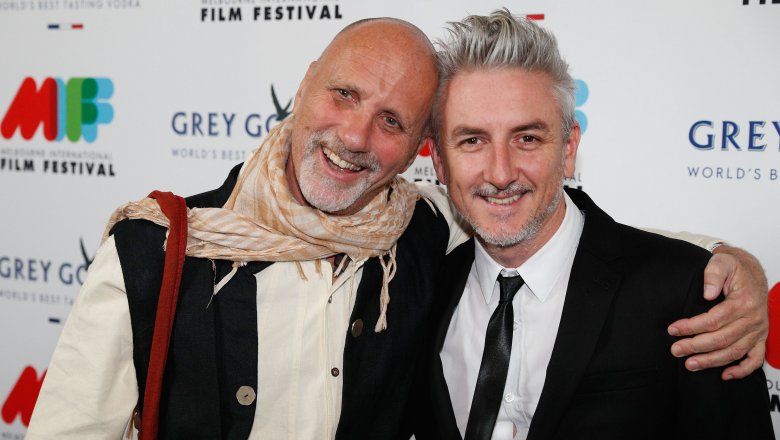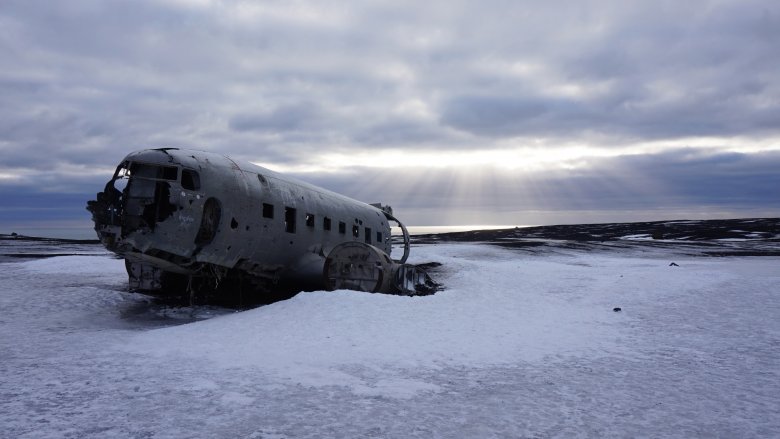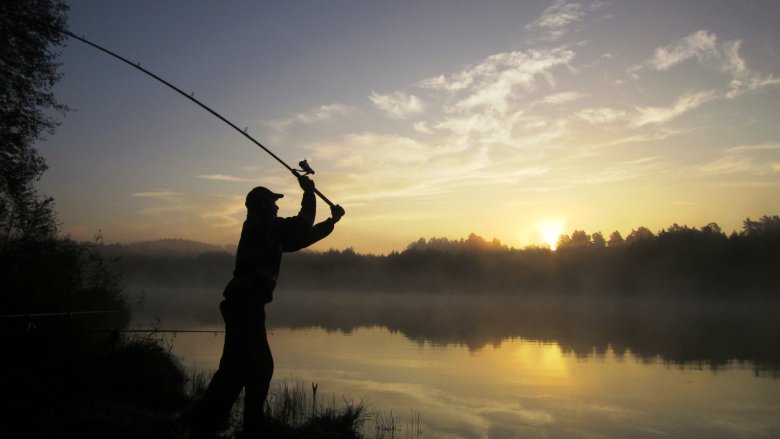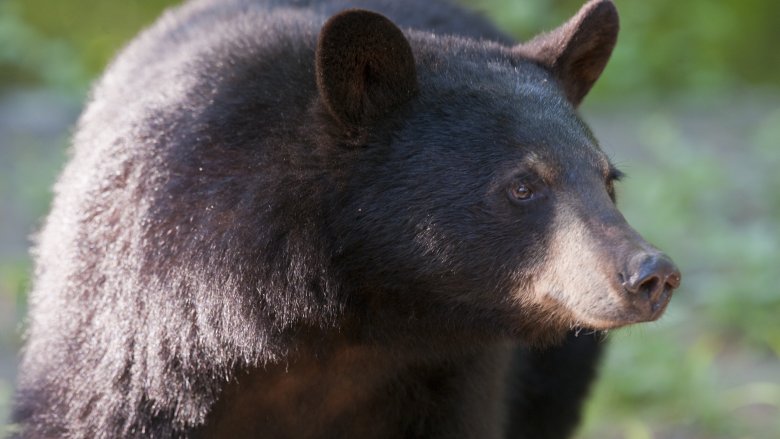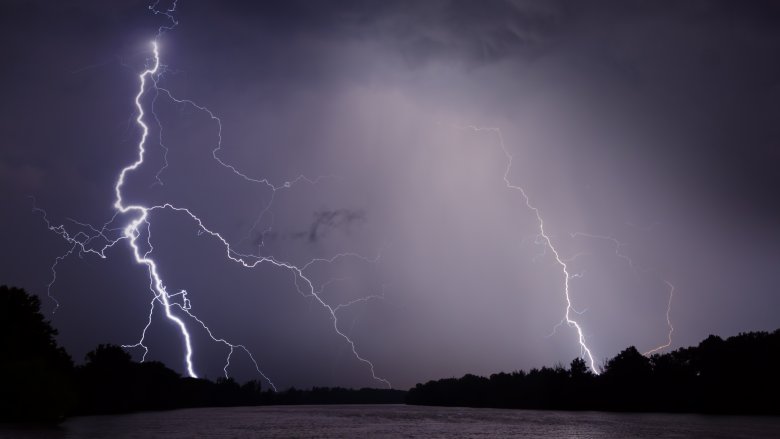The Most Incredible Wilderness Survival Stories Ever
We may receive a commission on purchases made from links.
Probably the only thing nature abhors more than a vacuum is a human. The great outdoors can turn on us in an instant if we don't do everything right, and even if we do there's no guarantee of safety. But people are resilient, and not even nature's harshest punishments can kill us every time. Here are some amazing tales of people getting pummeled by the wilderness and living to tell the tale.
Ricky Megee did not have a g'day, mate
We often hear stories of the animals in Australia that want us dead. For Ricky Megee, however, no Australian critter was worse than Australia itself.
As detailed in The National, in January 2006 Megee was driving through Australia's Northern Territory. Three men waved him down, claiming they had no gas. In fact, they had no scruples, being robbers who slipped a drug into Megee's drink, robbed him of virtually everything while he was passed out, and threw him in a shallow grave to die.
Once Megee awoke, he was alone, had no working phone, no water, no food, no shoes, and no hope. After two days, he was forced to start drinking his own urine, and didn't eat anything until the fifth day. He eventually found a dam with water and such culinary delights as raw frogs, lizards, and leeches. Later, after several rounds of heat exhaustion and dehydration, he found a better dam with more water. He stayed there for almost two months, but man cannot live on tiny insects alone, and Megee began to waste away. Everything from getting water to simply waking up and walking around took massive effort.
Finally, after 71 days, Megee was rescued by nearby station-hands, who just happened to be surveying the area. By that time, he had dropped from 230 pounds to a skeletal 99 pounds, making his survival nothing short of a miracle.
Joe Simpson fell thousands of feet and was mostly fine
In 1985, Joe Simpson and his friend Simon Yates were climbing the Siula Grande peak of the Peruvian Andes. Despite it being 21,000 feet high they made it, but once the descent began, trouble started. Simpson fell and destroyed his leg just before an unexpected, blinding snowstorm hit. If you've never tried to scale a mountain with a broken leg, don't.
Yates attempted to rescue Simpson by laying him on a makeshift stretcher tied to a rope and gradually lowering him until the rope reached its limit. That worked until, as Simpson told People, he was accidentally lowered over a super-deep crevasse. Gravity started pulling Yates toward the cliff, and he had to cut the rope to avoid careening to the ground below. This, however, sent Simpson into the crevasse. He landed on a narrow shelf inside, but Yates didn't realize this and returned to the campsite overcome with grief and guilt.
But Yates had unknowingly saved his friend's life. Simpson crashed through soft snow, breaking his fall enough to keep him both alive and conscious. He then crawled 6 miles back to camp (it took him about 60 hours to do so), relieving Yates of the feeling that he had just brutally murdered his friend.
Along with the broken leg, Simpson lost about 42 pounds on the mountain. But he came out living, plus he got to write a book and make a movie about his ordeal, which are all better alternatives to death.
Jan Baalsrud nearly froze to death, but it was better than Nazis
Jan Baalsrud was a Norwegian who opposed the Nazis, and since he did so in an actual, Nazi-killing manner, his country's occupiers had a severe issue with him. As told by The Scotsman, after killing a couple Germans in a firefight, Baalsrud started running in the direction of Sweden, a neutral country where the Nazis couldn't get him.
He walked for almost a week, stopping periodically for food and shelter with sympathetic residents, and considering one of the Nazis shot him in the foot, that's pretty impressive. But then, an avalanche sent him plummeting 300 feet, catapulting his story from "impressive" to "legendary." He woke up concussed but kept stumbling in what he hoped was the direction of Sweden. He walked alone in the deep, blowing snow until he stumbled upon the village of Furuflaten, where the local Nazi resistance group nursed him back to health. They then brought him to some Lapps tribesmen in the Revdal mountain, who put him on a sled and whisked him into Sweden.
Baalsrud had survived, though he weighed about 80 pounds when he arrived in Furuflaten. Plus, he was so frostbitten he lost nine toes, which he had to amputate himself. But he lived, and went on to be knighted by the Queen of England. Time took him away in 1988, at age 70, long after both Nazis and the elements failed to do so.
Two men had the ultimate bad day in the mountains
Teenage buddies Tommy Hendricks and Matthew Smith were hiking in November 2016 when everything went wrong at the worst possible time. As they told Backpacker, they were halfway up the 1,200-foot Cross Couloir when a snowstorm arrived a day earlier than expected. They would've loved to climb back down, but the deep snow, blinding storm, and incoming darkness made that impossible. They couldn't climb down once at the peak either, since it was pitch-black and they couldn't see any paths. With 50 mph winds and temperatures reaching -20 degrees Fahrenheit, the pair resorted to rubbing their bare feet in each others' armpits to keep frostbite at bay.
They somehow survived the night, beginning their descent the next morning. Problem is, they went the wrong way, and had no cell reception to boot. They were also without food and were getting increasingly soaked with cold water by the step. Their compasses didn't work either, thanks to the iron in the nearby rocks interfering with the compass magnets. When their waterlogged lighters failed to start a fire, that's when Matt uttered what nobody wants to say or hear: "Tommy, we could die out here."
They were succumbing to hypothermia when a chopper arrived ... and then flew away. The boys finally gave up and tearfully accepted death. Luckily, the chopper returned an hour later and picked them up. Maybe the chopper pilot could have dropped them a note explaining that the chopper needed to refuel.
Marcus Mazzaferri battled Yosemite without his glasses
In May 2017, Marcus Mazzaferri was fording a raging river at Yosemite National Park when the water began to run too deep and he slipped on a rock. He was pulled under and lost both his gear and glasses to the rapids, but he made it to shore safely. He knew he was in trouble but told himself, according to his story in Backpacker, "I can do this. I'm not going to die out here. I'm not that Into The Wild kid. No one's going to write a book about me because I'm going to make it."
Mazzaferri attempted to follow his footprints back to a shelter (without glasses, that was all he could see), but darkness and the cold forced him to hunker down for the night. Knowing hypothermia could kill him if he slept, Mazzaferri would rest for 20 minutes, get up and exercise to keep from going numb, then rest another 20 minutes. In the morning, he set off on more hiking, but eventually lost track of his own footprints. Seeing no other options (or anything else, really), he started following deer tracks, which miraculously led him back to his own prints.
Eventually though, he ran out of tracks again and couldn't tell which direction to go. Luckily, he heard a plow crew across a freezing river. Despite being dangerously cold already, Mazzaferri followed the sound, swimming across the river to join his new best friends.
Yossi Ghinsberg's Amazon survival story was made for the movies
In 1981, Yossi Ghinsberg was traveling with three other people through the Bolivian Amazon. After a couple weeks of rough conditions, the group split into two. Tragically, one half was never seen again. Meanwhile, Ghinsberg and his friend Kevin headed off in a raft. It went fine until they lost control just before a waterfall; Ghinsberg was sent flying over the waterfall, now totally on his own.
Ghinsberg told The Jewish Chronicle that for three weeks, he just did what he could to survive. He lit bug spray to create a makeshift flamethrower and ward off a jaguar. He swiped eggs from nests and ate them raw (depending on the egg's progress, this was either breakfast or dinner). But overall, he ate very little, and was regularly attacked by all sorts of nasty creatures. One day it was fire ants, then a couple days later he battled termites. By the end, as he confessed to the Sydney Morning Herald, "I would have eaten human flesh. With hunger at that level, it's just energy. It's beyond disgust."
Amazingly, his rescue happened almost completely by accident. Kevin, his rafting buddy, had survived and was looking for him but thought he had failed. So he landed his boat to turn around and just happened to land exactly where Ghinsberg had collapsed. That's the definition of luck, though the grit and toughness needed to last that long is nothing short of Hollywood-worthy, so Daniel Radcliffe played him in the movie.
Donald Evans saved himself and his entire family
It's hard enough to help yourself after being injured in a plane crash, but with an entire family to save, things become exponentially harder. That's what makes Donald Evans' story so completely amazing.
On August 13, 2011, Evans and his family took a Cessna plane to their new home in Anvik, Alaska. Unfortunately, the skies turned cloudy, obscuring the pilot's view. They wound up crashing into a mountain, killing the pilot and another passenger immediately. When Evans came to, he found that his back, legs, jaw, and feet were broken, plus he had lost teeth. Worse, it initially seemed like his entire family was dead. They weren't, but they were critically injured. Bones were broken, his pregnant wife was coughing up blood, his son's body was crushed under the plane's floorboards, and his daughter's intestines were "severed." Meanwhile, Donald could barely walk but was doing his best to crawl to each family member and help as best he could.
Night fell, the temperature dropped, and no rescuers came. Donald worked to keep everyone awake, as falling asleep in weather this cold could have killed them. But after 15 hours, he had given up hope. He fed his family some oranges as a last meal, and then let them sleep. The National Guard had had other plans — a helicopter arrived just a few minutes later to collect everyone. Amazingly, they all survived, including their unborn daughter.
Mike Vilhauer had the worst fishing trip imaginable
August 6, 2014, was supposed to be just a regular California fishing day for Mike Vilhauer. He wasn't getting any bites, so he started wandering around looking for grasshoppers to use as bait. But he lost track of time and started heading back too late. He was forced to use a pine tree as shelter, and by the next day hunger and dehydration had taken over.
He solved the dehydration problem quickly, launching what he told ABC News was his "survivor man routine." This involved drinking puddle water, no matter how dirty and disgusting it might've been. Unfortunately, his problem with leaving the mountain proved harder to solve, as he kept going in circles and following rivers that led nowhere.
By the fourth day, he had reached his limit. He was cold, weak, exhausted, starving, and was running out of ideas. He found his way to a stream and began carving out a goodbye to his wife on a piece of wood. He also spelled out HELP using tree needles, one last stab at making sure his goodbye wouldn't be necessary.
The next morning, he ate a dandelion for his first food since getting lost, and shortly after that a search team finally found him. They'd been looking for him all weekend, in perhaps the biggest search-and-rescue mission of the year. The moral of the story: Get your bait before you go fishing.
Brent Prokulevich bear-ly made it out alive
This story doesn't involve weeks of wilderness survival, but when your goal is to not get mauled by a 300-pound bear, even a few minutes' survival is worth talking about.
Brent Prokulevich, according to his story in Field and Stream, was hunting moose in Western Ontario with only a bow and arrow for company. On the morning of September 26, 2011, he readied his bow and began some moose calls. Unfortunately for his hunt, no moose showed up. Unfortunately for his health, a black bear did. Once the bear saw him, Prokulevich yelled for him to leave. The bear didn't listen and ran to attack him.
Prokulevich attempted to shoot an arrow at the bear, who chomped down on his arm and stopped that dream. The two began to wrestle, and the bear bit down on his neck. Prokulevich, spurred by thoughts of leaving his son behind, got some energy. He stabbed the bear's head with an arrow until it gave up, and then the would-be moosehunter hightailed it out of there, searching for help for 15 minutes before boating back to camp, where he was taken to an emergency room.
As it turns out, Prokulevich had gotten super lucky. The bear's bites were inches away from puncturing his lung and damaging his spinal cord, so while he was certainly injured, he wasn't as mortally wounded as he could've been. Plus, now he has a story his son will never tire of hearing.
Graham Austin rode the lightning
On July 3, 2011, Graham Austin and his friends were hiking around the southern Appalachian Trail when a storm started brewing. As Austin told Backpacker, lightning struck out of nowhere shortly after the storm began. While it knocked his friends back and slightly injured them, it hit Austin directly, shredding his clothes and leaving his muscles, as he put it, "taut as bowstrings." The strike had also left a long scar from his head to his feet, like Harry Potter's mark taken to the extreme.
Had Austin been alone, the lightning likely would've killed him. His heart stopped for 30 seconds, he lost control of his breathing, and his blood-deprived legs were paralyzed and soon turned a deep shade of purple. Luckily, his friends were there and were able to perform CPR to get his heart started again, and rescue breathing to get oxygen flowing regularly. They also massaged blood back into his legs. They still weren't working properly when a rescue squad arrived roughly 90 minutes later, so they had to carry Austin down the mountain.
After about 90 more minutes of descent, Austin started to regain use of his legs. After 18 hours in the hospital, he was almost good as gold. Within a month all his muscles were back to normal, and the only evidence he had of his experience was a detailed, harrowing story.
